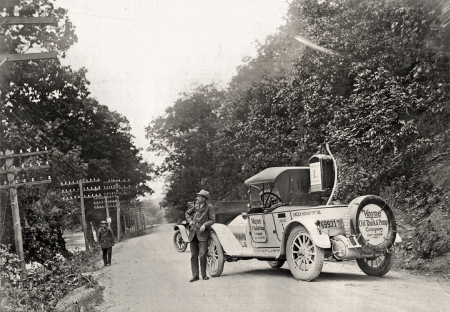LINCOLN HIGHWAY NEWS IS A BLOG BY BRIAN BUTKO
Beatrice Larned Massey, her husband, and their two friends had stopped in Harrisburg, Pa., then headed to Chambersburg, where they joined the Lincoln Highway. Now they pointed their new Packard twin-six touring car towards Bedford:

Unidentified tourists along the Juniata River east of Bedford, Pa. [University of Michigan–Special Collections Library, lhc2371.]
“Our third day was still a drizzle; we would no sooner have the top down than we would have to put it up again, and often the side curtains as well. Our objective point was the charmingly quaint town of Bedford, and the Bedford Arms. This part of Pennsylvania was more beautiful than what we had been through, and every mile of the day’s run was a pleasure.
“I have not spoken of our lunches, a most important item by one o’clock. We had brought a small English hamper, fitted with the usual porcelain dishes, cutlery, tin boxes, etc., for four people, and unless we were positive that a good place to eat was midway on the road, we prepared a lunch, or had the hotel put one up for us. This latter plan proved both expensive and unsatisfactory. Usually Toodles was sent foraging to the delicatessen shops for fresh rolls, cold meats and sandwiches, eggs, fruit, tomatoes, and bakery dainties, and the hotel filled our thermos bottles with hot coffee. We carried salt and pepper, mustard, sweet and sour pickles, or a relish, orange marmalade, or a fruit jam, in the hamper, and beyond that we took no staple supplies on the whole trip. We met so many people who carried with them a whole grocery-store, even to sacks of flour, that you would imagine there was not a place to get food from the Atlantic to the Pacific….
“We have been told so often that one has to develop an ‘open-air’ spirit to really enjoy a long motor trip! Quite true! I can’t imagine what the fun can be of touring in a closed limousine, and yet we have met that particularly exclusive party more than once. On the whole, an absence of flies, ants, mosquitoes, and sand and dust in one’s bed and food does not detract from the pleasure of the trip. It may be all right to endure such annoyances for a few days in the woods, to fish or hunt but weeks and more weeks of it….!
“But I have digressed, and left you at the Bedford Arms, one of the most artistic, attractive inns that we found. The little touches showed a woman’s hand. Flowers everywhere, dainty cretonnes, willow furniture, and pretty, fine china; in appearance, courtesy, and efficiency, the maids in the dining room might have come from a private dwelling.
“Will someone tell me why there are not more such charming places to stop at on our much-traveled main highways. Why must hotel men buy all the heavy, hideous furniture, the everlasting red or green carpets and impossible wall-paper, to make night hideous for their guests—to say nothing of the pictures on their walls? It is a wonder one can sleep.
“There is much of interest to see in Bedford—really old, artistic houses, not spoiled by modern gewgaws, set in lovely gardens of old-fashioned flowers, neatly trimmed hedges, and red brick walks. There were few early Victorian eyesores to mar the general beauty of the town. As we were walking down the main street about sunset, we heard a great chattering and chirping, as if a thousand birds were holding a jubilee. Looking up, we found, on a projecting balcony running along the front of all the buildings for two blocks, hundreds of martins discussing the League of Nations and Peace Treaty quite as vigorously as were their senatorial friends in Washington. They were fluttering about and making a very pretty picture. It sounded like the bird market in Paris on a Sunday morning, which, in passing, is an interesting sight that few tourists ever see.”






















